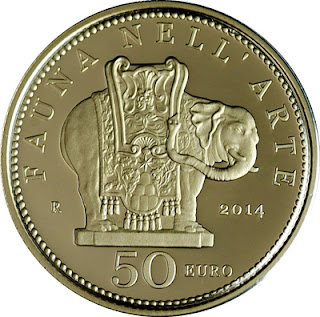Italy 50 Euro Gold Coin 2014 Baroque
Coins of the Italian Republic: Fauna in Art Series
Piazza della Minerva doubtless offers one of the most evocative sights of Rome; here Baroque is represented by one of its most extraordinary icons: the Elefantino, i.e. a small elephant, the famous sculpture made by Ercole Ferrata on a project by Gian Lorenzo Bernini, commissioned by Pope Alexander VII as an ideal structural and decorative base for the ancient Egyptian obelisk in pink granite.
Obverse: Piazza della Minerva, Rome. In the foreground an elephant carrying an ancient obelisk; all around, from left to right, the inscription “REPUBBLICA ITALIANA”; below, on the right, the name of the designer “V. DE SETA”; around, a dot decorated frame.
Reverse: The elephant of piazza della Minerva in Rome. It was sculpted as a base for the ancient obelisk which was uncovered under the convent annexed to the church of Santa Maria sopra Minerva; all around, from left to right, the inscription “FAUNA NELL’ARTE”; in the field, the letter “R” and the year of issue “2014”; below, the value “50 EURO”; around, a dot decorated frame.
SPECIFICATIONS
Denomination: 50 euro.
Metal: gold.
Fineness: legal 900 - tolerance ± 1 ‰.
Weight: 16.129 g - tolerance ± 5 ‰.
Diameter: 28 mm.
Finish: Proof.
Designer: Valerio De Seta.
Mintage: 1500.
Edge: continuous milled.
Proof: € 780.
Issue: 25/03/2014.
Elephant and Obelisk
Elephant and Obelisk is a sculpture designed by the Italian artist Gian Lorenzo Bernini. The elephant was probably executed by his assistant Ercole Ferrata; the Egyptian obelisk was uncovered during nearby excavations. It was unveiled in February 1667 in the Piazza della Minerva in Rome, adjacent to the church of Santa Maria sopra Minerva, where it stands today.
The image possibly originated from the Hypnerotomachia Polyphili of 1499. Various preparatory drawings done by Bernini exist. One version in Windsor Castle, UK was probably done in the 1630s when Cardinal Francesco Barberini wished to place an Egyptian obelisk in front of his family palace, the Palazzo Barberini. Nothing came of this specific project, but Bernini revived the idea in the 1660s, when Pope Alexander VII, Fabio Chigi, wished to build a similar monument after another Egyptian obelisk had been discovered in Rome.
Various other concepts were explored for this later commission as attested by preparatory drawings. It is likely that the drawings were used so that the patron could make a decision about which design he wanted. This include a drawing (in Leipzig) of the figure of Time holding a scythe and simultaneously the obelisk. In the Vatican Library there are two pen and ink drawings with other figures holding up the obelisk, including one of Hercules, and another with various allegorical figures supporting the spire. A third version in the Vatican Library shows Bernini adapting on the concept he created in the 1630s, although he added in a larger base, changed the direction of the elephant's orientation, and made its face appear more friendly than ferocious.
It turned out to be the last commission Pope Alexander VII would ask of Bernini, as he died in May 1667. He was succeeded by Pope Clement IX.
On 15 November 2016, Rome authorities announced they were searching for vandals who broke the left tusk the previous Sunday night and left the piece nearby. Mayor Virginia Raggi said that they will assess the damage to determine how to best reattach the fragment.
The statue makes a brief but prominent appearance in the Italian neorealist film Umberto D. (1952)
Piazza della Minerva
Piazza della Minerva is a piazza in Rome, Italy, near the Pantheon. Its name derives from the existence of a temple built on the site by Pompey dedicated to Minerva Calcidica, whose statue is now in the Vatican Museums.
Facing this piazza are:
- the church of Santa Maria sopra Minerva, centre of the square, already attested in the 8th century by the Anonymous of Einsiedeln by the name (ecclesia) "S. Mariae in Minervio". To the right of its facade are inscriptions built into the wall commemorating the flooding of the River Tiber between 1422 and 1598 - the area of the piazza is the lowest in Rome, and so was always the first to suffer in flooding.
- A convent (or casa professa) of the Dominicans, who held the nearby church from the 13th century. This expanded over time to Via del Seminario and to the church of San Macuto, in the space formerly occupied by three Roman temples - the aforementioned Minervium, the Iseum, and the Serapeum. From the 17th century, the convent became the base of the Roman Inquisition or Holy Office, and it housed the trial and recantation of Galileo Galilei. Little remains of the Dominican complex except its cloister: This had been largely rebuilt from the original building, and expropriated by the state in 1870 as the seat of the Ministry of Public Education and for a short time the Ministry of Post and Telecommunications. The cloister now holds the library of the Italian Senate, dedicated to Giovanni Spadolini.
- At the centre of the piazza, backing onto the Inquisition convent, is the 1667 Elephant and Obelisk by Bernini. This obelisk was excavated in the cloister and came from the Iseum. The elephant was known as "il pulcin della Minerva", or "porcino", from the Roman people's story that - uninspired by elephants - Bernini in fact sculpted a pig.
- To the right of the church stands the 16th century Palazzo Fonseca, since 1832 the site of one of the historic hotels of Rome, known as the Minerva, whose guests have included Stendhal and José de San Martín, remembered in plaques on the facade.
- Opposite the church is the Palazzo dell'accademia ecclesiastica (the former Accademia dei nobili ecclesiastici), 14th century in origin but completely rebuilt in 1878. It is an academy that trains the diplomats of Vatican City.

